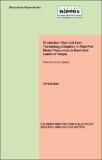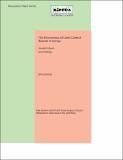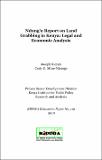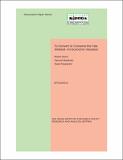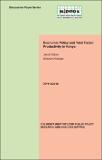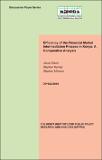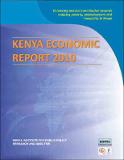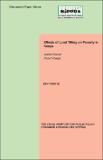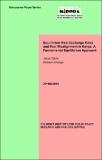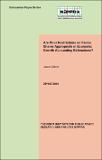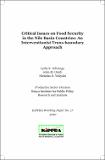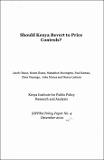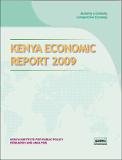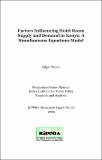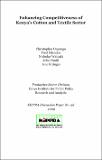3. KIPPRA Research Publications: Recent submissions
Now showing items 501-520 of 708
-
Discussion Paper No. 120 of 2010 on Production Risk and Farm Technology Adoption in Rain-Fed Maize Production in Semi-Arid Lands of Kenya
(The Kenya Institute for Public Policy Research and Analysis (KIPPRA), 2010)This study provides empirical evidence of technology adoption and the effects of production risk on it among smallholder farmers, using cross-sectional data collected from semi-arid districts in Kenya (Machakos and Taita ... -
Discussion Paper No. 114 of 2010 on Determinants of Regional Disparity in Kenya
(The Kenya Institute for Public Policy Research and Analysis (KIPPRA), 2010)Regional disparity is still a key development challenge in Kenya, despite government efforts to reduce it since independence. Given that regional production defines the relative state of a region’s welfare, this study ... -
Discussion Paper No. 115 of 2010 on The Economics of Land Control Boards in Kenya.
(The Kenya Institute for Public Policy Research and Analysis (KIPPRA), 2010)The paper develops a simple model of a landowner seeking the consent of Land Control Board (LCB). The model is based on the tradeoffs between the benefi ts and the cost of acquiring the consent. In the model, the landowner ... -
Discussion Paper No. 119 of 2010 on Ndung'u Report on Land Grabbing in Kenya: Legal and Economic Analysis
(The Kenya Institute for Public Policy Research and Analysis (KIPPRA), 2010)Land grabbing is one of the past injustices that the Constitution of Kenya 2010 and Sessional Paper No. 3 on National Land Policy of 2009 recommended for immediate attention. It is a post-independence phenomenon which ... -
Discussion Paper No. 116 of 2010 on To Convert or Conserve the Yala Wetland: an Economic Valuation
(The Kenya Institute for Public Policy Research and Analysis (KIPPRA), 2010)Yala wetland is one of the major wetlands in Kenya that not only supports a huge species of ecosystem, but also acts as a reservoir to Lake Victoria fisheries. Also, the swamp supports livelihood of the community by the ... -
Discussion Paper No. 118 of 2010 on The Role of Education and Training in Reducing Poverty and Unemployment in Kenya
(The Kenya Institute for Public Policy Research and Analysis (KIPPRA), 2010)Unemployment and poverty are major socio-economic challenges affecting most countries. They are associated with under-utilization of resources, while leading to low welfare status. In the past, the Kenya government has ... -
Discussion Paper No. 111 of 2010 on Economic Policy and Total Factor Productivity in Kenya.
(The Kenya Institute for Public Policy Research and Analysis (KIPPRA), 2010)Policy makers and development experts in many countries have had to deal with a decision on exactly what sources of economic growth they must target to achieve higher growth rates. Most development practitioners and ... -
Discussion Paper No. 122 of 2010 on Efficiency of the Financial Market Intermediation Process in Kenya: A Comparative Analysis
(The Kenya Institute for Public Policy Research and Analysis (KIPPRA), 2010)Interest rate margins have been used severally in literature to indicate the extent of financial sector repression and inefficiency. Wide interest margins are detrimental for savings mobilization and stifle investment ... -
Discussion Paper No. 117 of 2010 on Liberalization of Services and Its Implications on Agricultural Trade in Eastern Africa Region
(The Kenya Institute for Public Policy Research and Analysis (KIPPRA), 2010)This study analyses the effects of services liberalization on trade in agricultural commodities within the East African Community (EAC). Intra-EAC trade flows in agricultural goods are examined, as the region is frequently ... -
Discussion Paper No. 121 of 2010 on A Panel Data Analysis of the Determinants of Tourism Destination Competitiveness: Kenya and Compactor Countries in Africa
(The Kenya Institute for Public Policy Research and Analysis (KIPPRA), 2010)This study analyzes the determinants of tourism destination competitiveness using panel data for the period 1980 to 2008, based on an augmented version of an empirical model by Craigwell (2007). The analysis is based on ... -
Kenya Economic Report 2010 on Enhancing Sectoral Contribution Towards Reducing Poverty, Unemployment and Inequality in Kenya
(The Kenya Institute for Public Policy Research and Analysis (KIPPRA), 2010)The Kenya Economic Report (KER) 2010 is the second in a series of annual reports on the Kenyan economy prepared by the Kenya Institute for Public Policy Research and Analysis (KIPPRA). The report analyzes recent economic ... -
Discussion Paper No. 109 of 2010 on Evaluating the Impact of Microfranchising the Distribution of Anti-Malaria Drugs in Kenya on Mortality and Morbidity
(The Kenya Institute for Public Policy Research and Analysis (KIPPRA), 2010)In an effort to increase access to effective anti-malaria drugs to the rural poor, the Kenyan government has partnered with a local nongovernmental organization to distribute the drugs free of charge using a micro-franchise ... -
Discussion Paper No. 112 of 2010 on Effects of Land Titling on Poverty in Kenya
(The Kenya Institute for Public Policy Research and Analysis (KIPPRA), 2010)Kenya has a 50 year history of ongoing land reform. However, with multiple land tenure systems, including customary and statutory systems, past tenure reforms have not resolved inherent land ownership problems. These ... -
Discussion Paper No. 108 of 2010 on Equilibrium Real Exchange Rates and Real Misalignment in Kenya: A Fundamental Equilibrium Approach
(The Kenya Institute for Public Policy Research and Analysis (KIPPRA), 2010)With the liberalization of exchange rate in most countries, policy makers have to contend with erratic movements in exchange rates in the short-run, causing exchange rate misalignments in the long run. Exchange rate ... -
Discussion Paper No. 107 of 2010 on Are Prior Restrictions on Factor Shares Appropriate in Economic Growth Accounting Estimations?
(The Kenya Institute for Public Policy Research and Analysis (KIPPRA), 2010)Several studies make different prior assumptions on the magnitude of factor shares and scale of production when accounting for economic growth. The initial Solow estimations, for instance, assumed a capital share of 0.3 ... -
Working Paper No. 17 of 2010 on Critical Issues on Food Security in the Nile Basin Countries: An Interventionist Trans-boundary Approach
(The Kenya Institute for Public Policy Research and Analysis (KIPPRA), 2010)This study highlights critical issues on food security in the Nile Basin countries and priority investment areas to enhance food security. It presents the main causes of food insecurity at the household, national and ... -
Policy Paper No. 04 of 2010 on Should Kenya Revert to Price Controls?
(The Kenya Institute for Public Policy Research and Analysis, 2010)Prices of many essential items (including food items) in Kenya have sharply risen in the last few years. Such rises can have adverse consequences, including political and economic instability. In an attempt to address ... -
Kenya Economic Report 2009 on Building a Globally Competitive Economy
(The Kenya Institute for Public Policy Research and Analysis (KIPPRA), 2009)This report analyses Kenya’s recent economic performance, prospects for the medium-term period 2008/09-2011, and national competitiveness. In addition, it benchmarks Kenya’s performance against comparator and selected newly ... -
Discussion Paper No. 97 of 2009 on Factors Influencing Hotel Room Supply and Demand in Kenya: a Simultaneous Equations Model
(The Kenya Institute for Public Policy Research and Analysis (KIPPRA), 2009)Accommodation is a key component of the tourism industry in Kenya, which has been recognized as a key sector in the economic pillar of the country’s Vision 2030. Therefore, the envisaged growth of the tourism industry in ... -
Discussion Paper No. 98 of 2009 on Enhancing Competitiveness of Kenya's Cotton and Textile Sector
(The Kenya Institute for Public Policy Research and Analysis (KIPPRA), 2009)Cotton farming is a major source of livelihood for rural households in Kenya. It is characterized by a large number of small holder farmers, hence making it a priority crop for improving livelihood and reducing poverty. ...

